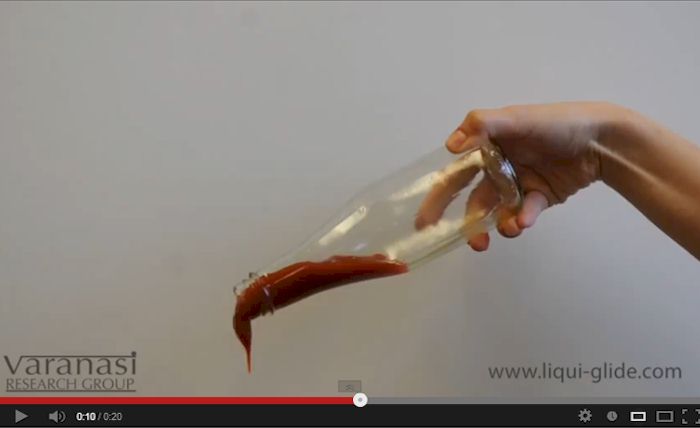|
ramé-hart instrument co.
January 2013 Newsletter |
| This is No Ordinary Ketchup Bottle |
|
In a year the world consumes 36 million
tons of ketchup.1 Wow. That's a lot of ketchup. And no one
consumes more ketchup (per capita) than Americans. As much as we love
ketchup, most of us have a love/hate relationship with the condiment: we
love to get the delicious thick tomatoey sauce on our hamburger;
but we hate all the tapping, shaking, and tricks required to get the
stuff out of the bottle.
What most people don't realize is that ketchup is a pseudoplastic - or, in other words, a shear thinning fluid. This means that in a static state, it's quite thick. However, as it begins to flow, the viscosity decreases. This helps us understand why ketchup flows out of the bottle - once you get it flowing. However, to get it started all sorts of magic tricks. As a result, we end up throwing away about 5% of it just because we can't get it out of the bottle. This translates to a couple million tons of ketchup per year worldwide. Researchers at MIT2 are working on a new development that will not only reduce food waste, but make dispensing ketchup and other condiments less physically challenging. They have developed an edible lubricant which turns the inside of just about any type of condiment bottle (glass or plastic) into a non-stick surface. Currently, they are in the process of commercializing this novel invention under the name of LiquiGlide.3 The LiquiGlide researchers came in second in the 2012 MIT $100k Entrepreneurship Competition.
While LiquiGlide, which is made from materials on the FDA-approved food material list, seems to be a proven solution to the ketchup dilemma, it also works well with mayonnaise, mustard and other condiments. There are myriad other potential applications - from keeping ice off airplane wings to improving the flow in oil and gas lines. And so now, to answer the question "How did these MIT researchers measure contact angle and other wetting properties of LiquiGlide-treated surfaces?", as you may have guessed, they are using a ramé-hart Goniometer / Tensiometer Model 590 with Automated Tilting Base and Automated Dispensing System. 1
http://tinyurl.com/c752ygo |
| Ten Surface Science Trends to Watch in 2013 |
|
As you can see from the above article,
contact angle and wetting properties affect many aspects of our lives -
even down to the way our condiments are dispensed. Here are ten surface
science related trends and
technologies to watch for in 2013: 1. Superhydrophobic Coatings. In addition to the LiquiGlide product detailed in the article above, other researchers are working on superhydrophobic coatings and treatments that promise to make our lives better. Ross Technologies NeverWet spray-on coating, for example, promises to make clothes, shoes, and toilet plungers repel water. To learn more, watch this video: http://youtu.be/7is6r6zXFDc. 2. Superoleophobic Glass Coatings. As tablets and smartphones take on an increasingly important role in our lives, researchers are looking for new ways to keep the displays free from finger smudges and other contaminants. See our article on this topic in our February 2012 Newsletter: http://www.ramehart.com/newsletters/2012-02_news.htm. 3. Researchers are exploring ways to decrease interfacial tension in order to improve fracking techniques which will lead to high oil and gas production levels with fewer chemicals and surfactants. More on fracking and interfacial tension here: http://www.ramehart.com/newsletters/2012-01_news.htm 4. Electrowetting, or using an electric field to change the wetting properties of a surface, is being used to develop products such as adjustable lenses and electronic displays (such as those used on e-readers). An example of a polymer used in electrowetting applications is FluoroPel by Cytonix. 5. Graphene promises to solve design challenges and is being used to develop display screens, integrated circuits, solar cells, and many other products. More on graphene in our August newsletter: http://www.ramehart.com/newsletters/2012-08_news.htm 6. Battery design has come a long way in the past decade. As hybrid vehicles are becoming more commonplace and more able to compete with gas-powered vehicles, watch for big changes in battery design which will shorten charge time, extend drive time, and lower weight. Mobile device battery technology also has ample room for improvement. Wildcat Discovery Technologies is one such company that is developing new battery materials. 7. MEMS (Microelectromechanical Systems) technology will continue to improve and find its way onto new electronic products in the form of sensors, actuators, accelerometers, gyroscopes, and switching. Diverse industries, from biotech to automotive, are benefitting from designs that implement MEMS components. 8. Nanomaterials will continue to lead to new and innovative applications and solutions to problems in many industries. Cambrios Technologies, for example, is developing nano-wire based films used in new generation touchscreen designs. This new material replaces costly indium tin oxide. 9. Improved solar power. New methods and materials are being used to design and build ultra-efficient solar panels. Superhydrophic coatings and films, for example, contribute to self-cleaning panel designs. New designs include solar shingles and local solar grids for developing countries. Companies at the cutting edge of solar power development include Semprius and SunPower. 10. The development of biomaterials. Wetting behavior and contact angle help to determine biocompatibility with living tissue for dental implants, contact lenses, and heart devices. Itaconix polymers, for example, contribute to a new generation of body-friendly biocompatible products. Wishing you a Healthy and
Superhydrophilic New Year. |
|
Regards,
Carl Clegg |


